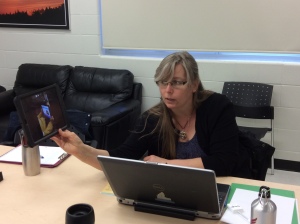 My second visit to Kawartha Pine Ridge DSB happened a couple of weeks ago in Bowmanville. It was great to hear what the teachers were able to accomplish in their Learning Connections project and how they were engaging their students in deeper, more relevant research to improve student skills in this area. You can read more about their project on their LC Project Page and have a look at their video:
My second visit to Kawartha Pine Ridge DSB happened a couple of weeks ago in Bowmanville. It was great to hear what the teachers were able to accomplish in their Learning Connections project and how they were engaging their students in deeper, more relevant research to improve student skills in this area. You can read more about their project on their LC Project Page and have a look at their video:
KPRDSB from abelearn on Vimeo.
The morning was spent with each teacher librarian sharing their personal inquiry, the activities they did with their students leading to their big learning. Here are some examples:
If I teach students to effectively, efficiently search for and identify appropriate website,using advance search, then students will be able to use their time and resources more efficiently in order to become more competent, confident digital literate learners.
Activity: After teaching what  makes an effective website and how to evaluate a website the teacher gave the students a list of fake websites to evaluate and determine their validity based on the premise that they would have to do research on that topic.
makes an effective website and how to evaluate a website the teacher gave the students a list of fake websites to evaluate and determine their validity based on the premise that they would have to do research on that topic.
Result: All students from grades 3-6 thought the sites were real!
Big learning: Have to start early in the year to teach students how to evaluate websites.
If I focus on questioning related to the topic, then the students will gather relevant information.
Activity: Students in Kindergarten used Pebble Go to research questions of interest for science and technology. The teacher found it was challenging to keep the students focussed on their questions as they got distracted in their exploration of Pebble Go. On the up side, students who were not  readers, yet could use the reading option in the app to have it read to them.
readers, yet could use the reading option in the app to have it read to them.
Big learning: Students were more successful than teacher thought they would be even if they couldn’t read. Realized that they have to start earlier and have student do more research in Pebble. Also, would be good to have students create a play or story board of what they learned to help consolidate their learning.
If I teach intermediate students how to collect and organize reliable information they can access from anywhere, then they will experience less frustration and greater success completing research projects.
Activity: Using technology to support student research, the teacher created a team of 3 students who became experts on the tools. The “tech team” met a week before the tool was introduced to the class to learn ahead of time and then be abel to support their peers. The benefit of this was that these students had extra time to learn the tool and the teacher was not the only support in the classroom. It was also a great leadership experience for these students.
Big learning: The teacher recognized that she had to front load the skills for the students. It was important to focus on giving them the skills to be successful before working on the content.
 In the afternoon, we had a chance to experience the coding and robotics initiative taking place in one of the libraries. Using Arduino, students code to create different projects with the kits. The book that comes with the Arduino kits is a great place to start challenging your students. So fun to play and learn how the students learn. Although I find the pieces in the Arduino kits a little too small to work with – it is really great to consolidate concepts of circuits along with the other skills gained from coding.
In the afternoon, we had a chance to experience the coding and robotics initiative taking place in one of the libraries. Using Arduino, students code to create different projects with the kits. The book that comes with the Arduino kits is a great place to start challenging your students. So fun to play and learn how the students learn. Although I find the pieces in the Arduino kits a little too small to work with – it is really great to consolidate concepts of circuits along with the other skills gained from coding.
What a great day of learning with a great team! Thanks for including me in your day 🙂